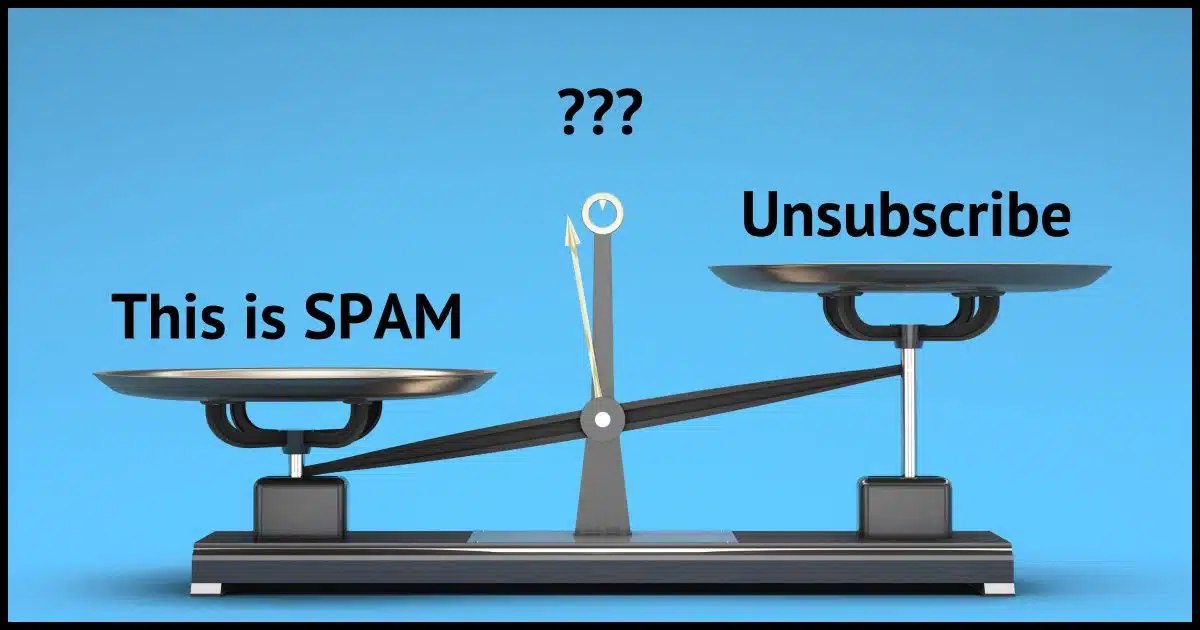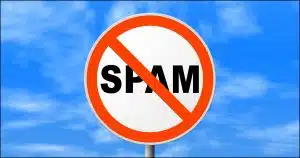There are some you absolutely should not.

I know this is confusing, but it’s important to realize that there are emails you can and should unsubscribe from and emails you absolutely should never, ever unsubscribe from.
I’ll explain why that is and share the relatively simple rules.
Become a Patron of Ask Leo! and go ad-free!

When to unsubscribe
- Never “unsubscribe” from spam. It will only result in more spam.
- Unsubscribe from things you originally subscribed to or for which there was a legitimate business relationship.
- Mark spam as spam. That’s all.
Don’t unsubscribe from spam
What you are getting is most likely spam. Spam is sent to random email addresses. You haven’t been “subscribed” at all. You’re just getting it like many people do: randomly.
This is important: since you haven’t subscribed, there’s nothing to unsubscribe from, even if there’s an “unsubscribe” link. Clicking on that unsubscribe link will not help. In fact, it’ll likely make matters worse.
You might be asking, “If I’m not subscribed, why is there an unsubscribe link?”
Spammers lie.
As I said, spam is sent out at random to email addresses. Some are legitimate email accounts and some are not. The act of clicking that “unsubscribe” link confirms to the spammer that your email address is a real, valid email address with a real person reading it.
From the spammer’s perspective, it means “We got us a live one!”
And once they know the email address is legitimate, they’ll start sending you MORE spam, not less.
Thus this rule of thumb:
“Unsubscribing” from spam only gets you more spam.
Instead, click on the “This is Spam” (or Junk) button in your email program or interface to get the email out of your inbox and train that service what spam looks like. That helps the service better identify spam in the future and is by far the safest, most effective approach to dealing with spam using tools you already have at your disposal.
But what about email to which you did subscribe and now don’t want to see anymore?
Do unsubscribe from things you asked for
As a newsletter publisher myself, I want to emphasize that when you’re ready to stop receiving a legitimate mailing, a mailing that you subscribed to, you do want to use the unsubscribe link.
Do not click “This is spam” for legitimate email. When you click on “This is spam” for legitimate email, it may cause other people — people who actually want it — to stop getting it.
Once you unsubscribe, if the unsubscribe request is ignored for long enough — typically a week — then “This is spam” is the only recourse.
Opening email
With most modern email programs, it’s safe to open messages regardless of whether they’re spam. As long as your mail interface doesn’t display images by default (one of the ways that spammers can track you), there’s nothing wrong with taking a peek.
If the email is legitimate, then of course you’ll need to open the email to see and click on the legitimate unsubscribe link.
If you can tell that the email is spam, you don’t need to open it at all. You don’t want to click on any links within, so there’s no need. Mark it as spam and move on.
Do this
The rules are simple.
- If you subscribed to a newsletter, clicked “Yes, send me more info”, or have some kind of business relationship with the entity sending you email (such as having purchased something from them in the past), then it’s probably legitimate mail, and you should use the unsubscribe link.
- If you’ve never heard of the sender and have no relationship with whatever is being promoted or discussed in the email, then it’s likely spam, and you should not use the unsubscribe link. Use “This is spam” instead.
It’s unfortunate we even have to think about these things, but the fact is, spam continues to be a problem. Fortunately, a few moments of thought (“Is this email legitimate?”) and the simple rules above should make it fairly clear when it is and is not safe to unsubscribe.





I am in a variation of SPAM hell. Several years ago, my email address was included with a friend who’s bank login was hacked. The hackers apparently used a web server that had a long list of openly subscribable distribution lists. Retail merchants, churches, community newsletters, etc. Most appeared to be smaller web sites which probably didn’t have good web designer skills to include a subscription verification mechanism, such as a positive response to confirm the subscription.
At the time, the hackers accomplished their goal – the bank notifications that my friend’s email address was being changed and confirming a very large transfer were obfuscated by the massive SPAM volume he was receiving, mostly welcoming him to new lists, when it happened. Fortunately, the bank was on top of potential threats and called him before making the transfer. The onslaught of SPAM subsided after a few days. For me, it was a gmail account that was included in the SPAM onslaught and even several years later, in spite of a generally very good SPAM filtering mechanism which I routinely train, I periodically get a new series of SPAM emails, often welcoming me to a new retailer list.
As far as I can tell, most of these retailers and other organizations are real. They are often in foreign countries, and usually target local customers with their email content.
Depending on my available time, I do sometimes take the time to “Unsubscribe” from these lists since the retailer or organization appears to be an unwitting victim of having my email added to their subscription list. When I have a batch of these emails and I use the Gmail ‘SPAM’ button, there is usually an option to “unsubscribe and mark as SPAM”. I know that using an “Unsubscribe” link can sometimes do more harm than good, giving a system a positive verification that I am a real person, but so many of these lists appear to be handled by reputable emailing tools that it seems better to get myself permanently on their do-not-email list.
I wish there was a better way to reach out to web site administrators and designers to educate them on the need for a positive confirmation for new subscriptions. I am sure their “subscribe” buttons have been recorded to servers all over the internet as a tool for hackers to inundate unwitting consumers.
I’m not so merciful. If I get another email from a site I’ve unsubscribed from, I’ll mark it as spam. They should be doing it right or risk being penalized.
If a company I bought something from sends me ads when I haven’t specifically asked for ads, I mark them as spam. They fit the definition of unsolicited, unwanted emails.
I noticed outlook (the online email service, not the desktop application) now automatically unsubscribes users when marking email as “junk”. There’s no option to just block the email address if there is an unsubscribe link in the offending email.
I’ve always preferred to log into the web interface to filter spam at the source, but now I might have to use Thunderbird’s spam filter.
Am I missing something?
I have been getting those unsolicited/spam emails for years, I reverted back using a program/app called mail washer which I used to use on XP, after a month I find my unsolicited/spam emails has dropped to one or two a day. I had learned that unsubscribing from these emails created more. I use the free version of mail washer, I find that meets my needs.
This makes total sense. “If you didn’t subscribe to SPAM then there is nothing to unsubscribe from”. Sometimes I get frustrated from seeing the same email message over and over again on a daily basis, so I hit the Unsuscribe link only to have that email reappear again like clock-work the next day. One SPAM message I got from a Canadian company that sold vitamins, sent a daily Spam message to my Yahoo email for 10 years ! No matter what I did, I could not get rid of this Spam message. Yahoo mail has very notoriously weak anti-spam software, that’s why I switched to Gmail.
Don’t click the unsubscribe button. If it’s spam, it only invites more spam. Click the “mark as Spam” button to train Yahoo’s spam filter. I get almost no spam in my Yahoo spam catcher account’s inbox, and mo false positive in my spam folder. If Yahoo can keep my spam catcher inbox free of spam, I’d say it pretty good.
Hi Guys. I use a program called Mailwasher Pro I have for a few years now I am not trying to advertise this program try it for yourself it is pay for program what it does is when properly setup it allows you to see all of your emails on your server ie not delivered to you, you can then delete the emails you don’t want before they are sent to your computer, you only get the ones you want. Leo please try this program and report your findings at another time on your site
I’ve been evaluating it for a few weeks now.
Hi Leo, No added value here, just thankful appreciation.
Your take on “unsubscription” makes perfect sense. Very precise advice with clear reasons behind. I have followed Ask Leo for like 40 years, and have never doubted your views in it. Thanks again,
Hans
It is a good idea to check the spam-folder once in a while.
Real mails containing certain words may be mis-classified.
And also just for fun. Seeing all the spam in one place is quite entertaining.
I use gmail and find that detection here is very good. Combined amount of type-1 and type-2 errors less than 1%
Good advice, except for the second part. I get no entertainment from seeing spam.
Echoing Ron D. (July 16, 2024 at 8:55 am): Microsoft’s outlook (the online web-based email system) seems to have a new flaw. Recently, when I mark my junk folder contents as junk, I am told I will be unsubscribed. I don’t want to be unsubscribed. I want it flagged as junk. Any suggestions?
I get tons of spam emails on my Gmail. They all come from
@cpo.com The sender name is a bunch of letters with one letter that
is different in each one. Gmail needs to have a way that they can block
the @ address. I mark them spam & then delete. Sometimes it will
ask if I want to block them & I will.
Create a filter looking for “has the words @cpo.com”.